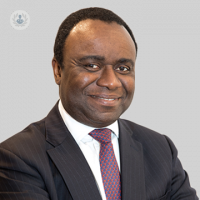Early onset scoliosis: Why it’s important to seek assistance
Written in association with:Leading adult and paediatric spinal deformity surgeon Mr Colin Nnadi discusses early onset scoliosis in children, including symptoms, treatment and diagnosis, in this informative article.

What are the common symptoms of early onset scoliosis?
The early symptoms of scoliosis are generally in the presentation and the history is usually from the parents, where they notice a curvature in the spine or asymmetry in the chest. Or, the fact that when they put on the child's clothes, particularly with trousers or nappies, they're lopsided. That usually alerts most parents to the fact that maybe there's something going on. Then, over time, if those appearances seem to get worse then a lot of parents will come to the doctor.
What are the treatment options available for children with early onset scoliosis?
Usually, if they present for the first time and it's very early on, then there's the option of monitoring the situation to see if will get worse.
Plaster jacket and bracing
If there's worsening of scoliosis, then at a very young age the treatment options consist of either applying a plaster jacket, serially. This means that you put the jacket on under general anaesthetic, and every three to four months the jacket is changed to keep up with the growth of the child. Or, when the child is a little bit older, you can then move on to braces which are like corsets that support and help to control scoliosis.
Surgical correction
If bracing fails, then you can start to open discussions whether surgical correction or surgery is necessary. Generally, in that age group if surgery is necessary, then you talk about growing rods which allow control of scoliosis but at the same time allow the child to continue with growth and development. Then the growing rods are continued into the early adolescent years when they can either be removed and be converted to a definitive posterior spinal fusion to make sure there's a permanent correction on the scoliosis. Or, they're then removed and the child is left alone. That's often down to the surgeon.
How is early onset scoliosis diagnosed, and what tests are involved?
The simplest diagnosis is often made by the parents, as I said. They see the deformity and then alert the health professional. Once they're in the hospital setting, the two main ways of confirmation of diagnosis is physical examination and radiological investigation.
Radiological investigation
Basic radiological investigation is an X-ray. And on the X-ray, you're looking at the size of the curve and there are any other abnormalities that may suggest there's an underlying condition. You're not only looking at the size of the curve, you're looking at the spinal column itself to see if there are any abnormal vertebrae. You're looking at the ribs to make sure they're equal on both sides. You're looking at the pelvis and the size of the chest wall. There are different things that you look at, but basically, it's physical examination and radiological investigations.
Are there exercises or physical therapies that can help manage early onset scoliosis?
I suppose this is a controversial area, and in recent years a lot of new, if you like, therapies, have come into focus in terms of managing scoliosis. So, there's:
- physiotherapy;
- a new form of therapy called the Schroth method. This focusses on exercises in and around brace control. The exercises are intense, often lasting hours each day, and for many weeks. These are to try and bring about control or correction of the scoliosis, and also improve breathing. I think the jury's still out as to whether traditional physiotherapy is more effective than the newer therapies.
Generally speaking, it's not a bad idea to try exercises to help maintain the curve in addition to the more traditional approaches, like bracing or plaster jackets. It's also important to bear in mind that sometimes, despite these therapies, the curves will still progress and may eventually require surgical intervention.
What are the potential complications or long-term effects of untreated early onset scoliosis?
The main complications, if untreated, is that firstly, the curve has significant potential to get worse particularly at the age where a child is still growing and developing. If unchecked, that can lead to problems with breathing, problems with the heart, and even problems with feeding.
By default, it can then cause problems with growth and development; not just physical but psychological as well. These children are often afflicted with respiratory ailments which can keep them out of school. They may feel isolated from their friends because they're in hospital all the time and there's a risk it could have an impact of their cardiac function.
Then, even in some cases where you have very severe curves, it can affect their feeding habits because the stomach is squashed. So instead of having regular meals, they tend to have smaller and frequent meals.
All that added together leads to a lifetime of ill health, and even in very severe cases, there's earlier mortality than the general population.
If you're concerned about early onset scoliosis in your child and want to arrange a consultation with Mr Nnadi, you can do so via his Top Doctors profile.


